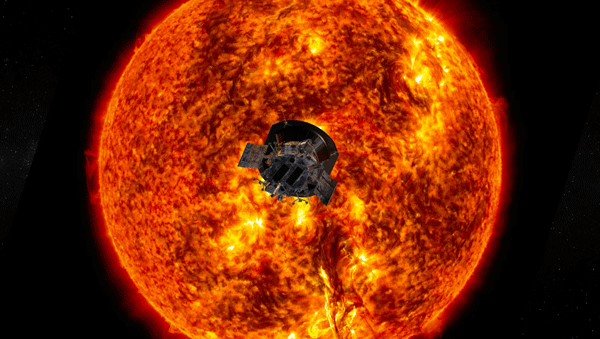
In August 2018, the Parker Solar Probe launched, looking at our solar system’s center. The probe is the first to study the Sun up close. Last year, we ran down the mission objectives of the exciting mission. But just this month, the scientific team behind the probe released its first set of observations. The results were revelatory.
One of the biggest learnings so far is on the solar wind. Observed near Earth, the solar wind is a relatively uniform flow of plasma, with occasional turbulent tumbles. But by that point it’s traveled over ninety million miles — and the signatures of the Sun’s exact mechanisms for heating and accelerating the solar wind are wiped out. Closer to the solar wind’s source, Parker Solar Probe saw a much different picture: a complicated, active system.

Like the Sun itself, the solar wind is made up of plasma, where negatively charged electrons have separated from positively charged ions, creating a sea of free-floating particles with individual electric charge. These free-floating particles mean plasma carries electric and magnetic fields, and changes in the plasma often make marks on those fields.
The FIELDS instruments surveyed the state of the solar wind by measuring and carefully analyzing how the electric and magnetic fields around the spacecraft changed over time, along with measuring waves in the nearby plasma.
Near Earth, we see the solar wind flowing almost radially — meaning it’s streaming directly from the Sun, straight out in all directions. But the Sun rotates as it releases the solar wind; before it breaks free, the solar wind was spinning along with it.
This is a bit like children riding on a playground park carousel – the atmosphere rotates with the Sun much like the outer part of the carousel rotates, but the farther you go from the center, the faster you are moving in space. A child on the edge might jump off and would, at that point, move in a straight line outward, rather than continue rotating. In a similar way, there’s some point between the Sun and Earth, the solar wind transitions from rotating along with the Sun to flowing directly outwards, or radially, like we see from Earth.
Exactly where the solar wind transitions from a rotational flow to a perfectly radial flow has implications for how the Sun sheds energy. Finding that point may help us better understand the lifecycle of other stars or the formation of protoplanetary disks, the dense disks of gas and dust around young stars that eventually coalesce into planets.
Now, for the first time — rather than just seeing that straight flow that we see near Earth — Parker Solar Probe was able to observe the solar wind while it was still rotating. It’s as if Parker Solar Probe got a view of the whirling carousel directly for the first time, not just the children jumping off it. Parker Solar Probe’s solar wind instrument detected rotation starting more than 20 million miles from the Sun, and as Parker approached its perihelion point, the speed of the rotation increased. The strength of the circulation was stronger than many scientists had predicted, but it also transitioned more quickly than predicted to an outward flow, which is what helps mask these effects from where we usually sit, about 93 million miles from the Sun.
The probe has only made four of 24 planned passes of the Sun. Scientists will surely be pouring over the data it brings in for years to come.
Here’s a video from NASA on the mission these tremendous findings.








